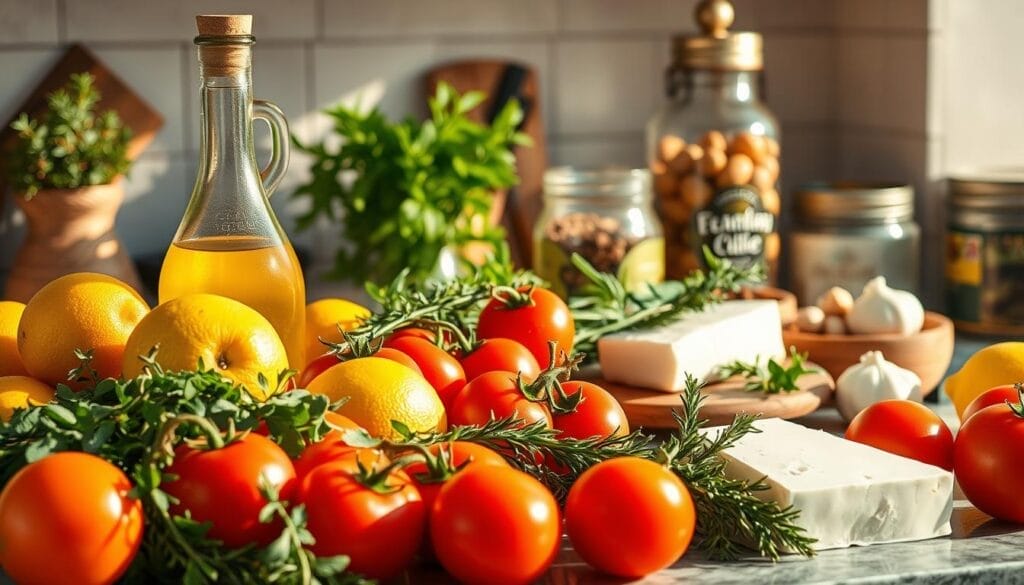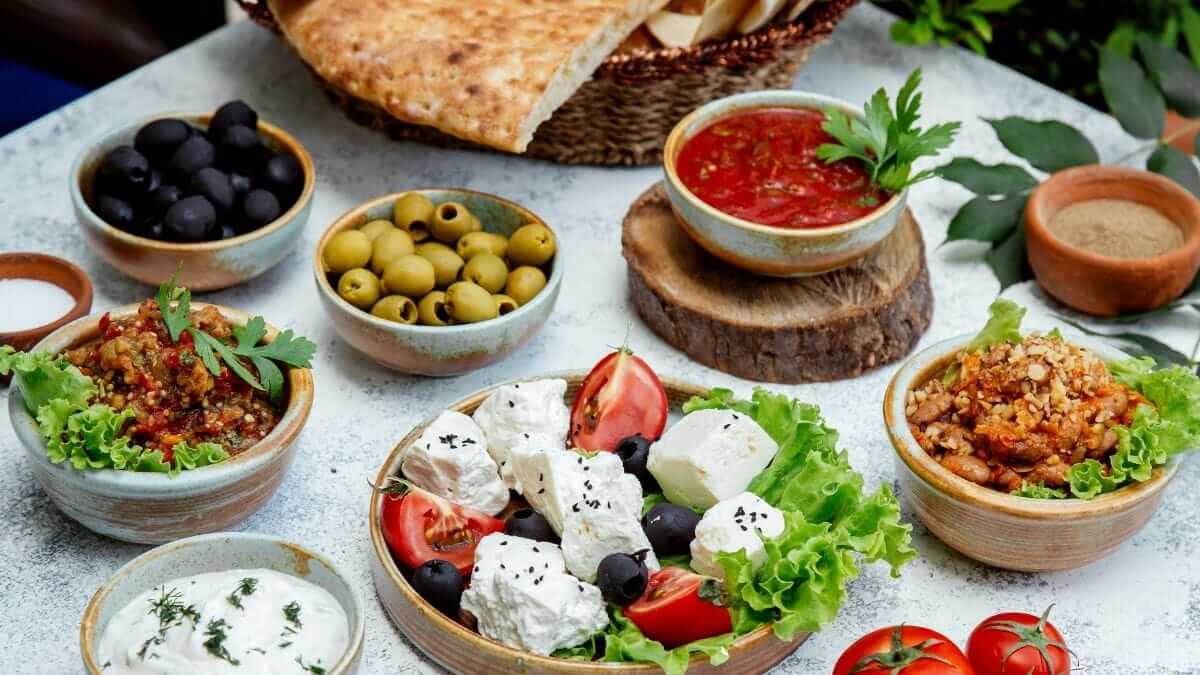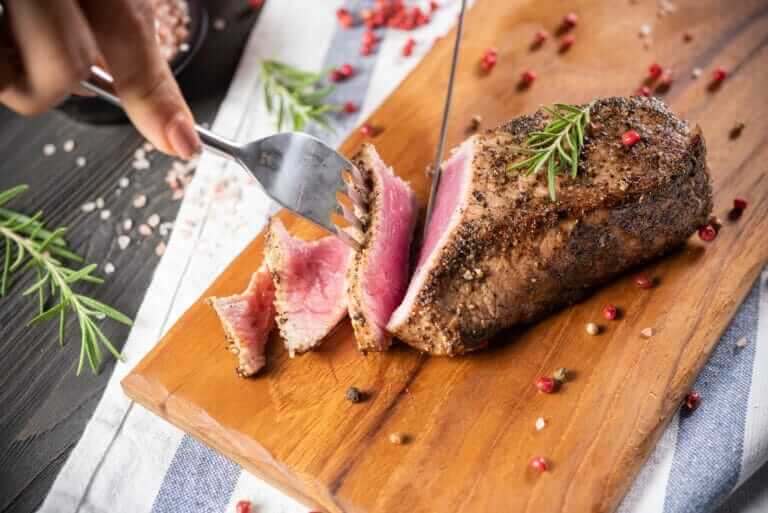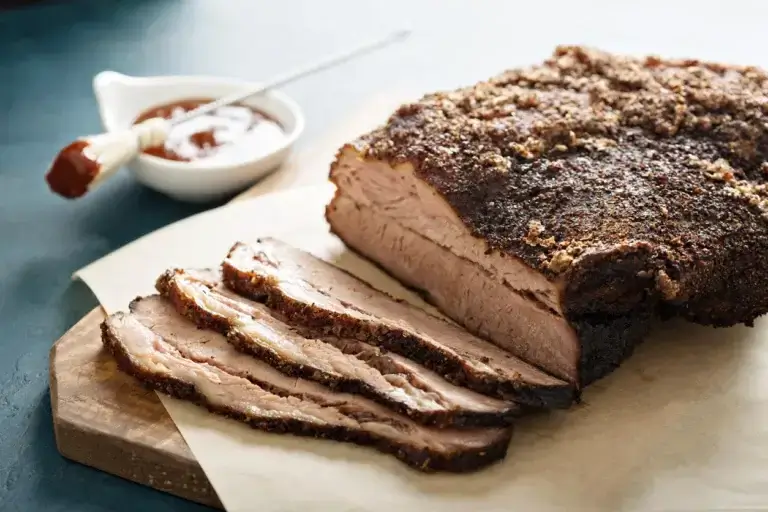Traditional Greek Cooking Tips for Beginners
Table of Contents
Imagine sitting at a sunlit table in a small Greek village. The air is filled with the scent of oregano and lemon zest. This is the magic of traditional Greek cooking. It’s not just food; it’s a link to generations of stories and flavors.
If you’re new to cooking or interested in Mediterranean cuisine, this guide is for you. It will make your kitchen a doorway to Greece’s culinary heart.
Key Takeaways
- Master foundational techniques like slow simmering and herb infusion.
- Discover how olive oil and fresh herbs elevate everyday meals.
- Learn to balance bold flavors without overcomplicating dishes.
- Understand how Mediterranean cuisine prioritizes freshness and simplicity.
- Confidently adapt classic recipes using ingredients from your local store.
The Heart and Soul of Traditional Greek Cooking
Traditional Greek cooking is more than recipes. It’s a long tradition that values health and nature. The Mediterranean diet, key to Greek cuisine, uses olive oil, veggies, and fresh herbs. This helps us see why Greek dishes are all about balance and simplicity.
The Mediterranean Diet Foundation
This diet is more than food; it’s a lifestyle. Imagine grilled veggies, lemon-marinated fish, and whole-grain breads. It’s good for your heart and has inspired people worldwide. Traditional Greek cooking uses seasonal ingredients, making every dish lively and fresh.
Regional Variations in Greek Cuisine
Greece’s varied landscapes influence its flavors. Check out these regional specialties in the table below:
| Region | Signature Dishes |
|---|---|
| Aegean Islands | Freshly caught seafood, avgolemono soup |
| Peloponnese | Lamb stifado, stuffed grape leaves |
| Crete | Dakos salad, myzithra cheese |
| Macedonia | Tzatziki, spanakopita |
The Philosophy Behind Greek Food Preparation
- Simplicity: Minimal seasoning let ingredients shine.
- Freshness: Markets supply ingredients daily.
- Community: Meals are shared, not rushed.
“A meal without friends is just food,” says a Greek proverb. This mindset turns every dish into an experience.
These principles make Greek dishes more than just food. They tell stories of culture and connection. Learning them is the first step on your culinary journey.
Essential Greek Ingredients Every Kitchen Needs
Starting a pantry for Greek dishes means getting the basics right. These key ingredients bring the heart of Mediterranean cuisine to your table. Let’s look at what every home cook should have.

Olive Oil: The Liquid Gold
For dressings and low-heat cooking, go for extra virgin olive oil. Refined olive oil is better for frying. Greeks love quality, so pick brands with Protected Designation of Origin labels.
Fresh vs. Dried Herbs
- Oregano: Fresh for salads, dried for long-cooking stews
- Dill: Fresh in tzatziki, dried in fish marinades
- Mint: Fresh in drinks, dried for meat rubs
Cheese Varieties
| Cheese | Flavor | Use |
|---|---|---|
| Feta | Salty, tangy | Salads, pies, omelets |
| Kefalograviera | Sharp, nutty | Grated over vegetables or baked into pasta |
| Manouri | Creamy, buttery | Spread on bread or dessert topping |
Grains and Legumes
These staples are the foundation:
- Orzo: Perfect for broth-based salads
- Krisharaki (cracked wheat): Foundation of kouskous
- Gigantes beans: Essential in soups and baked dishes
With these items, you’re set to make Mediterranean cuisine with true authenticity.
Kitchen Tools and Equipment for Authentic Greek Meals
Preparing Greek meals at home needs more than just ingredients. The right tools are key to getting the flavors of traditional Greek cooking. Start with a briki for thick, aromatic Greek coffee, a staple in many meals. A mortar and pestle are essential for grinding fresh herbs like oregano and thyme, unlocking their full aroma.
- Briki: A small copper pot for brewing coffee with rich crema.
- Cast-iron skillet: Ideal for searing meats and simmering stews like moussaka layers.
- Phyllo dough rolling pin: Ensures even layers in pastries like spanakopita.
You don’t need to import everything. A standard oven-safe baking dish works for Greek meals like gemista (stuffed vegetables). A quality grater is perfect for shredding potatoes or zucchini. For baking, parchment paper keeps phyllo dough from sticking, avoiding soggy layers.
“The briki isn’t just a pot—it’s the heartbeat of any Greek kitchen.”
Invest in a wide, shallow tray for baking baklava, letting layers crisp evenly. A wooden spoon is a must for stirring sauces without scratching non-stick pans. If specialty items are hard to find, prioritize a mortar and pestle and a good knife set. These basics let you focus on techniques rather than equipment gaps.
These tools turn your kitchen into a space where traditional Greek cooking feels achievable. They’re not just gadgets—they’re bridges to centuries-old methods, making every dish a true taste of Greece.
Mastering Basic Greek Flavor Profiles
Learning to balance flavors is key to cooking authentic Greek dishes. These techniques turn simple ingredients into meals bursting with Mediterranean soul.
The Lemon-Olive Oil Combination
This duo is the backbone of many dishes of Greece. Mix 3 parts olive oil with 1 part lemon juice for salads or proteins. A squeeze of lemon at the end adds brightness without overpowering.
- Marinate vegetables with this blend before grilling.
- Drizzle over grilled meats or feta cheese for instant freshness.
Working with Garlic and Onions
Greeks use these aromatics to build depth, not strong flavors. Sauté minced garlic in olive oil until golden, never burnt. Pair with caramelized onions for layers of sweetness in soups like avgolemono or stews like stifado.
Balancing Herbs and Spices
Herbs define regional dishes of Greece. Use this guide to pair flavors:
| Herb/Spice | Role | Example Dish |
|---|---|---|
| Oregano | Finishes meats and vegetables | Moussaka |
| Dill | Highlights fish dishes | Lemon-dill salmon |
| Thyme | Infuses roasted vegetables | Roasted potatoes with thyme |
The Art of Seasoning Greek Dishes

“Salt late, taste often.”
Season near the end of cooking to let flavors meld. Add salt to tomatoes last to prevent bitterness. Taste regularly and adjust with a pinch of red pepper flakes or sumac for warmth.
Practice these profiles and you’ll unlock the soul of Greek cooking. Every bite should feel like a taste of the Aegean—fresh, bold, and balanced.
Slow Cooking Techniques in Dishes of Greece
Patience turns simple ingredients into the heart of Mediterranean cuisine. Traditional Greek dishes like stifado and youvetsi use sigá-sigá. This slow simmering method tenderizes meats and blends spices, creating deep flavors.
“The best dishes of Greece are cooked with the heartbeat of a turtle.” – Greek Proverb
Begin with a clay pot or Dutch oven. Brown the meats first, then add onions, tomatoes. Simmer on low heat, stirring now and then. For youvetsi, mix pasta and meat sauce early to soak up all the flavors.
- Use a slow cooker on low for 6-8 hours for tender stews.
- Add vegetables like carrots and celery mid-cook to preserve texture.
- Season simply—let ingredients speak without overwhelming herbs.
The secret of Mediterranean cuisine is slow cooking. Even busy people can make it work by prepping in the morning. Let the flavors meld while you’re busy. The outcome? Meals that seem to have been cooking since dawn, full of the patience that makes Greek dishes special.
Greek Main Dishes: Cooking Methods and Preparations
Turn your kitchen into a taste of Greece with these essential techniques. Whether grilling, layering casseroles, or stuffing vegetables, these methods bring authenticity to your Greek meals. You don’t need to go to the Aegean to enjoy them.
Grilling Techniques for Souvlaki and Beyond
Perfect souvlaki starts with marinated meat skewers. Marinate pork or chicken in lemon, oregano, and garlic for at least an hour. Grill over medium-high heat, rotating skewers for even char. Pro tip: Use a mix of charcoal and wood chips for subtle smokiness.
- Trim meat into 1.5-inch cubes to cook evenly
- Oil grates lightly before adding skewers
- Serve with lemon wedges and tzatziki for balance
Perfecting Moussaka: Layering and Baking
Moussaka’s magic lies in texture contrasts. Follow this step-by-step:
- Sauté minced lamb with onions and tomatoes
- Layer eggplant rounds brushed with olive oil, then top with meat mixture
- Finish with béchamel sauce and grated cheese
Bake at 375°F until bubbly. Let rest 10 minutes before slicing to keep layers intact.
Mastering Stuffed Vegetables (Gemista)
Stuffed peppers, tomatoes, and zucchini require patience but reward with vibrant flavor. Mix cooked rice, currants, pine nuts, and herbs in a 2:1 rice-to-herb ratio. Fill vegetables gently, leaving room for expansion. Simmer in a tomato-based broth until tender—about 45 minutes.
“Gemista are like edible time capsules—they carry the essence of Greek summers,” says Athens-based chef
Adapt these techniques using everyday ingredients. Start with marinated proteins, layered casseroles, or herb-stuffed veggies. Make Greek meals that taste authentically Mediterranean.
The Secrets to Perfect Greek Pastry
Mastering Greek pastry techniques can take your traditional Greek cooking to the next level. Begin with phyllo dough, handling it with care. Keep it covered in a damp cloth to prevent it from drying out. Brush each layer with butter for flaky layers that make dishes like spanakopita shine.
Working with Phyllo Dough
- Thaw dough slowly in the fridge overnight.
- Use a light touch when layering to avoid tearing.
- Preheat your oven to 375°F (190°C) for even browning.
Sweet vs. Savory Techniques
| Aspect | Sweet Greek Dishes | Savory Specialties |
|---|---|---|
| Filling Moisture | Drain excess liquid from nuts or honey mixtures | Use dry fillings like feta or spinach wrung of excess water |
| Baking Time | 45–50 minutes for caramelized edges | 30–35 minutes for golden crusts |
| Signature Examples | Baklava, kourabiedes | Tyropita, cheese pie |
Traditional Shapes and Folds
Shape is key! Triangular folds define tyropita, while spirals create strifti spanakopita. Practice folding in batches to perfect the signature Greek dishes like bougatsa’s half-moon pockets. Pro tip: Use a pastry brush to seal edges firmly for crisp results.
From Land to Sea: Greek Seafood Preparation
Seafood is a big part of Mediterranean cuisine. Greece’s coastal traditions show simple yet tasty ways to cook it. Try making psaremeni, which is grilling whole fish. Clean the fish, then season with lemon, olive oil, and oregano. Cook it skin-side down first for crispy skin and tender flesh.
Octopus needs special care to avoid being tough. Here’s how to cook it right:
- Boil in salted water with red wine for 45–60 minutes
- Shock in ice water to stop cooking
- Marinate in olive oil, lemon, and garlic before grilling
Small fish like sardines or anchovies are great in Greek meals. Grill them quickly over high heat. Serve with lemon and a drizzle of tahini sauce.
For soups, try psarosoupa. It’s made with tomatoes, fennel, and fresh dill, along with fish bones and chunks of white fish. Simmer it gently to blend the flavors. Garides saganaki is another favorite, with shrimp baked with tomatoes, feta, and ouzo.
If you can’t find Mediterranean seafood, use U.S. alternatives. For example, use striped bass instead of sea bass, or domestic shrimp. Always choose fresh or high-quality frozen seafood to keep the dish authentic.
Incorporating Greek Cooking into Your Weekly Meal Plan
Adding Greek dishes to your meals doesn’t have to overwhelm your kitchen. Begin by preparing ingredients in advance. Chop onions, marinate meats, or mix herbs on Sundays. This can save you up to 30% of your cooking time during the week.
Letting dishes like pastitsio or fasolada sit for a while can enhance their flavor. Here’s a simple plan to follow:
- Batch-cook grains and legumes for quick lunches
- Freeze prepped souvlaki skewers for last-minute dinners
- Use a slow cooker for giouvetsi while running errands
| Traditional Ingredient | American Substitute | Brand Examples |
|---|---|---|
| Myzithra cheese | Part-skim mozzarella | Galbani, Odysea Feta |
| Crumbled oregano | Dried Italian seasoning | McCormick, Simply Organic |
| Kalamata olives | Domestic black olives | Calrod, Lucero |
Pair Greek dishes with foods you already like. Serve spanakopita with tacos or add avgolemono sauce to pasta. Keep these items in your pantry:
- Whole grain couscous (Barilla or Bob’s Red Mill)
- Pre-chopped frozen vegetables
- Rotisserie chicken for quick sauces
Here’s a sample meal plan: Monday—stuffed peppers with quinoa, Wednesday—shrimp saganaki over spaghetti, Friday—leftover moussaka as a lunch bowl. By mixing Greek dishes into your daily meals, it becomes a regular part of your routine.
Common Mistakes When Cooking Greek Food (And How to Avoid Them)
Mastering dishes of Greece requires attention to detail. Here’s how to avoid pitfalls that even seasoned cooks face:
- Overcooking vegetables: Souvlaki or gemista can lose their vibrant crunch. Steam or lightly sauté to keep colors bright and textures fresh.
- Wrong oil choices: Extra virgin olive oil burns at high heat. Use regular olive oil for frying souvlaki or stifado to prevent bitterness.
- Ignoring ingredient freshness: Store-bought feta lacks the tang of Greek-made cheese. Opt for high-quality imports or substitute with dry-cured feta.
| Mistake | Solution |
|---|---|
| Dry moussaka | Layer eggplant slices thinly and bake separately before assembling |
| Soggy spanakopita | Pat spinach dry thoroughly before mixing with phyllo |
| Timing Issues | Fix |
|---|---|
| Late components | Prep ingredients in batches and refrigerate until ready to assemble |
Many American kitchens use less flavorful produce. Boost depth with lemon juice or Kalamata olive brine. Taste as you go—traditional Greek cooking relies on balance, not excess seasoning.
Conclusion: Embracing the Mediterranean Way in Your Kitchen
Traditional Greek cooking is more than just recipes. It’s a way of life that connects us through food. By using herbs and slow-cooking, you can make meals that are fresh and simple. Whether it’s a spanakopita for dinner or a moussaka for the weekend, these methods honor both health and tradition.
Start small to incorporate these ideas into your cooking. Try making your own sauces or using seasonal vegetables. Websites like the Greek Food Bloggers Network and cookbooks like “The Foods of Greece” by Aglaia Kremezi are great resources. You can also take local cooking classes to learn more about Mediterranean techniques.
Adapting Greek cooking to your kitchen is easy. Let fresh ingredients guide you. Use herbs from your garden, local cheeses, and pantry staples like kalamata olives. Share meals with family to enjoy them together. Over time, your kitchen will become a place where tradition and modern life meet. Every bite celebrates centuries-old wisdom that’s still relevant today.
FAQ
What are some must-try popular Greek dishes?
You should try moussaka, souvlaki, and spanakopita. These dishes show off the rich flavors and cooking techniques of Mediterranean cuisine.
How can I start cooking authentic Greek meals at home?
Start by getting Greek ingredients like olive oil, fresh herbs, and cheeses. Learning basic cooking methods and recipes will help you make real Greek dishes.
What makes Greek main dishes unique?
Greek main dishes use fresh ingredients and special cooking methods. They grill, slow cook, and layer flavors, showing the Mediterranean diet’s spirit.
Can Greek cooking be healthy?
Yes! Greek cooking is based on the Mediterranean diet. It focuses on veggies, whole grains, healthy fats, and lean proteins, offering many health benefits.
What are the best substitutes for hard-to-find Greek ingredients?
Use similar alternatives for hard-to-find ingredients. For example, goat cheese can replace feta. Also, use local, in-season veggies for that authentic taste.
How can I adapt traditional Greek recipes for American ingredients?
Find ingredient substitutes that keep flavors and textures the same. Use local spices and herbs that match Greek ones to recreate your favorite Greek dishes.







